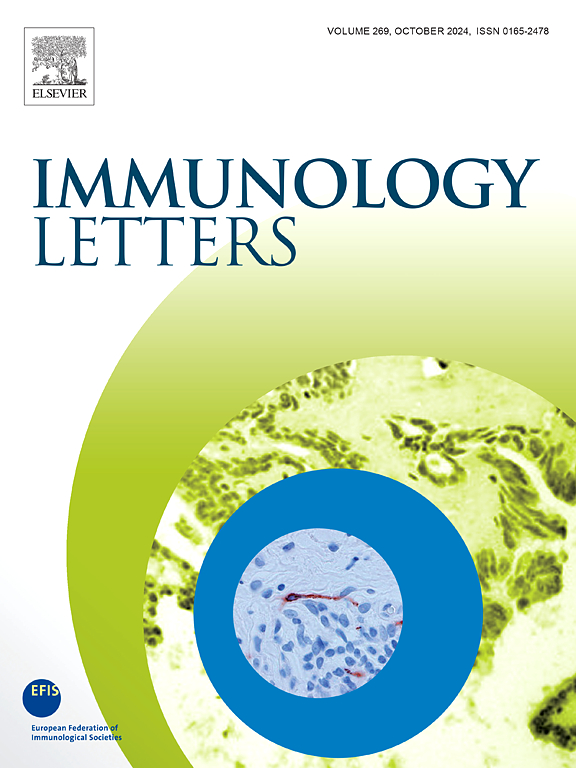糖rna在免疫调节和识别中的新作用。
IF 2.8
4区 医学
Q3 IMMUNOLOGY
引用次数: 0
摘要
糖基化,即多糖与生物分子的酶连接,是一种重要的翻译后修饰,影响蛋白质稳定性、免疫识别和细胞通讯。传统上与蛋白质和脂质相关,最近的发现揭示了糖基化RNA (glycoRNAs)的存在,扩大了我们对RNA修饰的理解。GlycoRNAs挑战了传统的范式,表明糖基化可能调节RNA的稳定性、定位以及与聚糖结合蛋白(如唾液酸结合免疫球蛋白型凝集素(Siglecs)和选择素)的相互作用。这些相互作用在免疫系统中尤为重要,其中糖基化在抗原识别、免疫细胞运输和病原体检测中起着关键作用。糖rna在免疫调节和疾病中的潜在影响是深远的,在自身免疫性疾病、癌症和传染病中发挥作用。糖生物学的进步,包括质谱、RNA测序、聚糖微阵列和点击化学技术,正在推动glycoRNA研究及其转化应用的发展。了解糖rna可以带来新的治疗机会,包括糖工程、生物标志物发现和靶向免疫干预。尽管存在丰度低、结构复杂等挑战,但对glycoRNA的研究进展迅速,揭示了其在免疫反应和疾病机制中的作用。本文综述了目前关于糖rna的知识,强调了它们在免疫学中的新兴意义,并概述了未来的研究方向。本文章由计算机程序翻译,如有差异,请以英文原文为准。
The emerging role of GlycoRNAs in immune regulation and recognition
Glycosylation, the enzymatic attachment of glycans to biomolecules, is a vital post-translational modification that impacts protein stability, immune recognition, and cellular communication. Traditionally associated with proteins and lipids, recent discoveries have revealed the existence of glycosylated RNAs (glycoRNAs), expanding our understanding of RNA modifications. GlycoRNAs challenge conventional paradigms by suggesting that glycosylation may regulate RNA stability, localization, and interactions with glycan-binding proteins, such as sialic acid-binding immunoglobulin-type lectins (Siglecs) and selectins. These interactions are particularly significant in the immune system, where glycosylation plays a key role in antigen recognition, immune cell trafficking, and pathogen detection.
The potential implications of glycoRNAs in immune regulation and disease are profound, with roles in autoimmune disorders, cancer, and infectious diseases. Advances in glycobiology, including mass spectrometry, RNA sequencing, glycan microarrays, and click chemistry technologies, are driving the growth of glycoRNA research and its translational applications. Understanding glycoRNAs could lead to new therapeutic opportunities, including glycoengineering, biomarker discovery, and targeted immune interventions. Despite challenges including low abundance and complex structure, research into glycoRNA is progressing rapidly, revealing their roles in immune responses and disease mechanisms. This review synthesizes the current knowledge on glycoRNAs, highlighting their emerging significance in immunology and outlining future research directions.
求助全文
通过发布文献求助,成功后即可免费获取论文全文。
去求助
来源期刊

Immunology letters
医学-免疫学
CiteScore
7.60
自引率
0.00%
发文量
86
审稿时长
44 days
期刊介绍:
Immunology Letters provides a vehicle for the speedy publication of experimental papers, (mini)Reviews and Letters to the Editor addressing all aspects of molecular and cellular immunology. The essential criteria for publication will be clarity, experimental soundness and novelty. Results contradictory to current accepted thinking or ideas divergent from actual dogmas will be considered for publication provided that they are based on solid experimental findings.
Preference will be given to papers of immediate importance to other investigators, either by their experimental data, new ideas or new methodology. Scientific correspondence to the Editor-in-Chief related to the published papers may also be accepted provided that they are short and scientifically relevant to the papers mentioned, in order to provide a continuing forum for discussion.
 求助内容:
求助内容: 应助结果提醒方式:
应助结果提醒方式:


